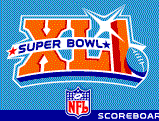The following is a list of all the commercials, promotions, and/or sponsorships that were broadcast during the commercial breaks of Superbowl XLI. I did not collect mentions and logos that appeared during actual game play. Everything I collected occurred in the commercial breaks. Beginning with pod 01-00, Ford Trucks broadcast the last commercial before the hard open. I did not record the length of each spot nor did I differentiate between :60, :30, :15, :10, or :05 spots.
Position ---- Advertiser ---- Commercial
01-00 ---- Ford Trucks ---- Assembly (lead-in spot)
01-01 ---- Budweiser ---- Low Five (Rock, Paper, Scissors)
01-02 ---- Doritos ---- Smooth
01-03 ---- Blockbuster Online ---- Carl & Ray Mouse Click
01-04 ---- CBS Promos ---- CBS Evening News with Katie Couric
01-05 ---- Superbowl ---- Prince Halftime Show
02-01 ---- Sierra Mist ---- Beard Combover
02-02 ---- Salesgenie.com ---- Sales Leads
02-03 ---- Sierra Mist ---- Karate
02-04 ---- Superbowl Sponsors ---- Budweiser
02-05 ---- Superbowl Sponsors ---- Pepsi
02-06 ---- Superbowl Sponsors ---- Federal Express
03-01 ---- Toyota ---- Tundra off a cliff
03-02 ---- Federal Express ---- Moon Office
03-03 ---- Bud Light ---- Wedding Auctioneer
03-04 ---- CBS Promos ---- Amazing Race
03-05 ---- Superbowl ---- Prince Halftime Show
04-01 ---- Snickers ---- Lady & The Tramp Kiss
04-02 ---- Schick ---- Titanium Shaver
04-03 ---- Movie Release ---- Pride
04-04 ---- CBS Promos ---- Survivor Fiji
04-05 ---- Superbowl Sponsors ---- Toyota
04-06 ---- Superbowl Sponsors ---- Career Builder
05-01 ---- Chevrolet ---- Songs
05-02 ---- Bud Light ---- Foreign Students
05-03 ---- CBS Promos ---- Grammy Awards
05-04 ---- CBS Promos ---- Letterman & Oprah Promo
06-01 ---- godaddy.com ---- Marketing Department
06-02 ---- Coke ---- Grand Theft Auto Redux
06-03 ---- CBS Promos ---- CBS is #1
07-01 ---- Bud ---- Muddy Dog / Fire truck
07-02 ---- Garmin ---- Maposaurus
07-03 ---- CBS Promos ---- CBS Cares / NFL Mentor
07-04 ---- CBS Promos ---- Pro Bowl Promo
07-05 ---- CBS Promos ---- Grammy Awards
08-01 ---- Career Builder ---- Outdoor Office
08-02 ---- Doritos ---- Cleanup on Register 6
08-03 ---- Chevrolet ---- University of Washington Contest Spot
08-04 ---- Superbowl Sponsors ---- Chevrolet
08-05 ---- Superbowl Sponsors ---- Doritos
09-01 ---- Bud Light ---- Slap is in
09-02 ---- Beat Your Risk? ---- Heart Character beat up by illness characters
09-03 ---- United Way ---- Go United Way
09-04 ---- Superbowl ---- Prince Halftime Show
10-01 ---- General Motors ---- GM Robot Suicide
10-02 ---- Coke ---- Black History
10-03 ---- CBS Promos ---- Letterman & Dr. Phil Promo
10-04 ---- Superbowl Sponsors ---- General Motors
10-05 ---- Superbowl Sponsors ---- Budweiser
11-01 ---- Movie Release ---- Wild Hogs
11-02 ---- Sprint ---- Connectile Dysfunction
11-03 ---- Motorola ---- Football Video on Phone
11-04 ---- CBS Promos ---- How I Met Your Mother
11-05 ---- CBS Promos ---- Amazing Race
12-01 ---- Doritos ---- Black History
13-01 ---- Coke ---- What Else Haven't I Done?
14-01 ---- CBS Promos ---- Rules of Engagement
14-02 ---- CBS Promos ---- CSI (Vegas)
15-01 ---- CBS Promos ---- Two & 1/2 Men
15-02 ---- CBS Promos ---- CSI (Vegas)
15-03 ---- CBS Promos ---- Shark
15-04 ---- CBS Promos ---- March Madness (bubbles?)
15-05 ---- CBS Promos ---- Grammy Awards
15-06 ---- Ford Trucks ---- We're #1
15-07 ---- Chase Bank ---- Stoplight ATM Visit
15-08 ---- Acura ---- Aren't We Advanced?
15-09 ---- CBS Promos ---- CBS Evening News with Katie Couric
15-10 ---- Blockbuster Online ---- Blockbuster Halftime Show Sponsorship
16-01 ---- CBS Promos ---- NCIS / The Unit Combo
16-02 ---- CBS Promos ---- Survivor Fiji
16-03 ---- NFL Promo ---- Difference Makers
16-04 ---- Pepsi ---- Superbowl 41 Halftime Show Sponsorship
17-01 ---- CBS Promos ---- Criminal Minds
17-02 ---- CBS Promos ---- CSI Miami
17-03 ---- CBS Promos ---- Jericho
18-01 ---- CBS Promos ---- CBS Evening News with Katie Couric
18-02 ---- CBS Promos ---- CSI NY
18-03 ---- CBS Promos ---- Grammy Awards
18-04 ---- CBS Promos ---- Survivor Fiji
18-05 ---- Chevrolet ---- Chevy Trucks Best Coverage
18-06 ---- Cargill ---- Cute Animal Stuff
18-07 ---- MetroPCS ---- Call Network or Out of Network
18-08 ---- Honda Civic ---- Tron Homage
18-09 ---- CBS Promos ---- Local Affiliate
19-01 ---- Movie Release ---- Disney's Meet the Robinsons
19-02 ---- E-Trade ---- Robbed by Your Bank
19-03 ---- Coke ---- Extraordinary Production inside Coke Machine (long-form)
19-04 ---- CBS Promos ---- Craig Ferguson
19-05 ---- NFL Promo ---- Football
20-01 ---- Bud Light ---- Monkeys Planning a Break
20-02 ---- Revlon ---- Cheryl Crow Colors Her Hair
20-03 ---- Superbowl Sponsors ---- Bud.tv
20-04 ---- Superbowl Sponsors ---- ??? (Can't Read my Notes)
20-05 ---- Superbowl Sponsors ---- Wild Hogs
21-01 ---- Career Builder ---- Office Survivor
21-02 ---- Taco Bell ---- Lions Ricardo Montalban
21-03 ---- Van Heusen ---- Just Lucky or Knows How to Dress?
21-04 ---- Cadillac ---- Vote for SVP online
21-05 ---- CBS Promos ---- Two & 1/2 Men
22-01 ---- Toyota ---- Tundra up a ramp
22-02 ---- Emerald Nuts ---- Robert Goulet during nap time
22-03 ---- T-Mobile ---- Is this your Dad? Dwayne Wayne / Charles Barkley
22-04 ---- CBS Promos ---- Grammy Awards
22-05 ---- Superbowl Sponsors ---- Coke
22-06 ---- Superbowl Sponsors ---- Revlon
23-01 ---- Federal Express ---- Ground Service: Judging by a name
23-02 ---- Nationwide ---- Kevin Federline: Life Comes at You Fast
23-03 ---- Bud Light ---- Hitcher with an axe
23-04 ---- CBS Promos ---- CSI (Vegas)
24-01 ---- CBS Promos ---- CBS Sports
24-02 ---- Mitsubishi ---- Outlander - Out Everything
24-03 ---- Jack in the Box ---- I want to be a Vegetarian
24-04 ---- Dodge Trucks ---- Truck Stop Country
24-05 ---- CBS Promos ---- Local Affiliate CBS 11 Official Home of Cowboys
25-01 ---- Budweiser ---- Crabs Cooler Grab
25-02 ---- Prudential ---- What a rock can do
25-03 ---- Honda CRV ---- Hunk of Burning Love
25-04 ---- CBS Promos ---- Survivor Fiji
26-01 ---- Hewlett-Packard ---- Making the Computer Personal Again
26-02 ---- Izod ---- Melting Pot Sports
26-03 ---- Budweiser ---- Future Tabletop Football
26-04 ---- Superbowl Sponsors ---- Honda
26-05 ---- Superbowl Sponsors ---- Hewlett-Packard
26-06 ---- Superbowl Sponsors ---- E-Trade
27-01 ---- Flomax ---- Men who want to pee less
27-02 ---- E-Trade ---- Things to do with one finger
27-03 ---- CBS Promos ---- Rules of Engagement
28-01 ---- Movie Release ---- Hannibal Rising
28-02 ---- Career Builder ---- Outdoor Survivor - Torture
28-03 ---- CBS Promos ---- Criminal Minds
28-04 ---- Superbowl Sponsors ---- godaddy.com
28-05 ---- Superbowl Sponsors ---- bud.tv
29-01 ---- Honda ---- Gas Pumps Unneeded
29-02 ---- godaddy.com ---- Marketing Department
29-03 ---- Snapple ---- Green Tea Yogi
29-04 ---- NFL Promo ---- Its Hard to Say Goodbye
29-05 ---- CBS Promos ---- CSI Miami
30-01 ---- Michelin ---- A Better Way Forward
30-02 ---- Blockbuster Online ---- Total Access - Alec Baldwin
30-03 ---- Start Farm ---- Agents make the difference
30-04 ---- California Cheese ---- Happy Cows
30-05 ---- CBS Promos ---- Grammy Awards
30-06 ---- Lexus IL ---- So Much for Gravity
30-07 ---- Geico Insurance ---- Gecko in therapy
31-01 ---- Cadillac ---- Car Evolution
31-02 ---- Beat Your Risk? ---- Heart Character beat up by illness characters
31-03 ---- godaddy.com ---- Marketing Department
31-04 ---- Comcast ---- DSL Sucks but fast isn't for everyone
31-05 ---- Salesgenie.com ---- Sales Leads
32-01 ---- Cadillac ---- Tiki Barber and Opportunity
32-02 ---- Lunestra ---- Can't Sleep?
32-03 ---- Progressive Insurance ---- Insurance is cool
32-04 ---- CBS Promos ---- Rules of Engagement
32-05 ---- CBS Promos ---- Amazing Race
32-06 ---- NFL ---- Get your Superbowl hats & shirts at …
33-01 ---- Cadillac ---- Andy Garcia
33-02 ---- Netflix ---- 1 Billion Movies
33-03 ---- CBS Promos ---- Survivor Fiji
33-04 ---- Ford Trucks ---- Expedition Extended Length
33-05 ---- TXU ---- Pick Your Plan
33-06 ---- Mercedes ---- Every Owner Has a Story
33-07 ---- CBS Promos ---- Local Affiliate CBS 11
33-08 ---- Into Criminal Minds through Nance and Simms calling Superbowl…






